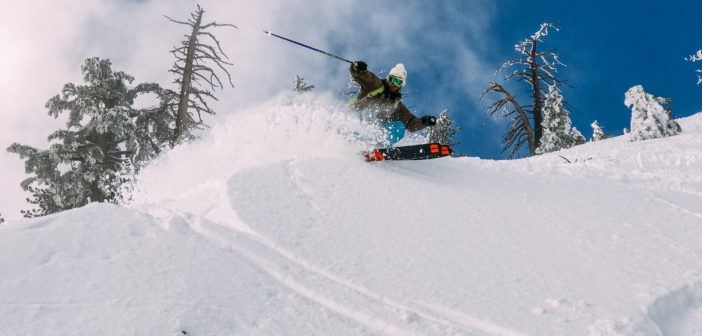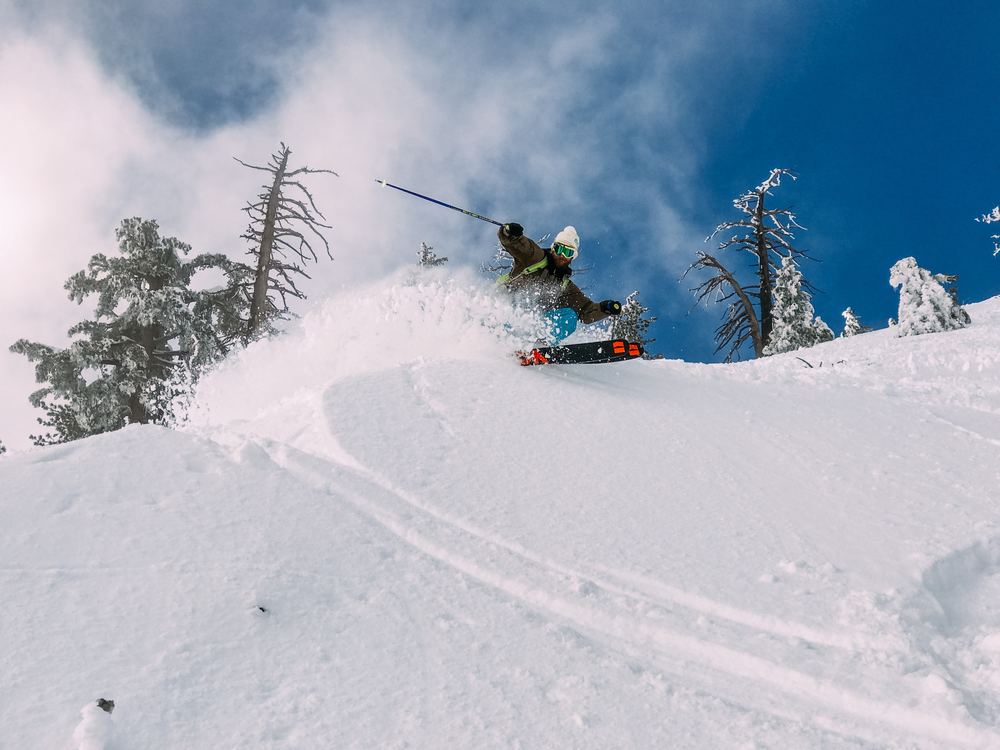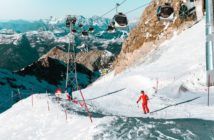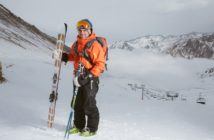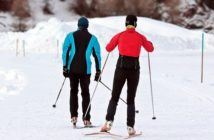Skiing through powder is a one-of-a-kind experience.
Looking to learn how? Take a gander at some of the tips gathered here and see what types of skills are needed to ski through some of winter’s best snow.
Contents
How to Ski Powder
Embracing the Powder
If you have never skied powder before, you might not understand just what you’re getting into.
Experienced skiers have referred to skiing through powder as heavenly; you are surrounded by soft, white fluff on every side, and you’ll go zipping through it as quickly as you can, to the point where it feels as though you’re flying.
Powdered snow is far different from the more traditional, packed snow that hobbyist skiers might be used to.
If you’re looking to tackle powder for the first time, then gliding off the ski lift and finding yourself in deep, fresh, fluffy snow that comes up to your knees – and sometimes even your hips – can be surprising!
Powdered snow is always fresh and falls as a result of El Niño or La Niña weather trends. Areas such as Jacksonhole, Wyoming, or Solitude, Utah, are renowned for the powder they draw during the colder months of the year.
In order to maneuver through this, you’re meant to use all of your body, as well as your skis and poles. The snow may look beautiful, but that doesn’t mean it won’t take effort.
Types of Powder Skis and Equipment
The right kind of equipment will make skiing through powder much easier. Many ski manufacturers produce gear specially designed to perform well for beginners learning how to ski in powder.
Do your best to take advantage of the deals they give you, and you will be on your way to a first-class experience in no time.
Skis
Naturally, when learning how to ski in fresh powder, you want the right kind of skis for the job.
All-mountain skis are ideal, so long as they have fat rockers that are wider than your boots. You want a fatter sort of ski, in order to better work with your environment and to adjust your stance accordingly.
Meridian skis, by Moment, or Ripstick skis, by Elan, are perfect for this sort of skiing – both skis are uniquely shaped to better tackle the deep and airy nature of the snow you’re running through.
Boots
No matter the situation, comfortable boots are essential tools of the trade. If you hit the slopes wearing ski boots that are too big or too small, you’re likely to end the day with either blisters or sore ankles.
Make sure that the boots you’ve chosen to wear are snug on your feet, and that they fit in well to the mounts on your skis.
Don’t hesitate to adjust your mounts so that they better fit your boots; most lodges will have someone available on hand to help if you want to get advice from an experienced hand.
Helmet
Hobbyist skiers and professionals alike should make use of helmets.
When preparing to ski through powder, you definitely want head protection on hand, because powder obscures the terrain you will be traversing.
Nasty falls are inevitable, and you may run into rocks or shifts you can’t see in the powder, so be safe instead of sorry!
Poles
Ski poles help you maneuver through the turns of a ski slope, as well as assist you in maintaining your balance.
While standard downhill skiing doesn’t require you to use poles, they are exceptionally useful when skiing through powder.
Not only will using your poles make it easier to find your center of balance, but they can be used to dig you out of the deeper areas of powder – should you get stuck.
The best poles for you depend on your height. When choosing your own set, take care to ensure that, when the grips of your poles are touching the floor, your elbows are bent at an angle.
If, while holding your skis, the angle of your elbow is less than ninety degrees, swap your poles out for a shorter set.
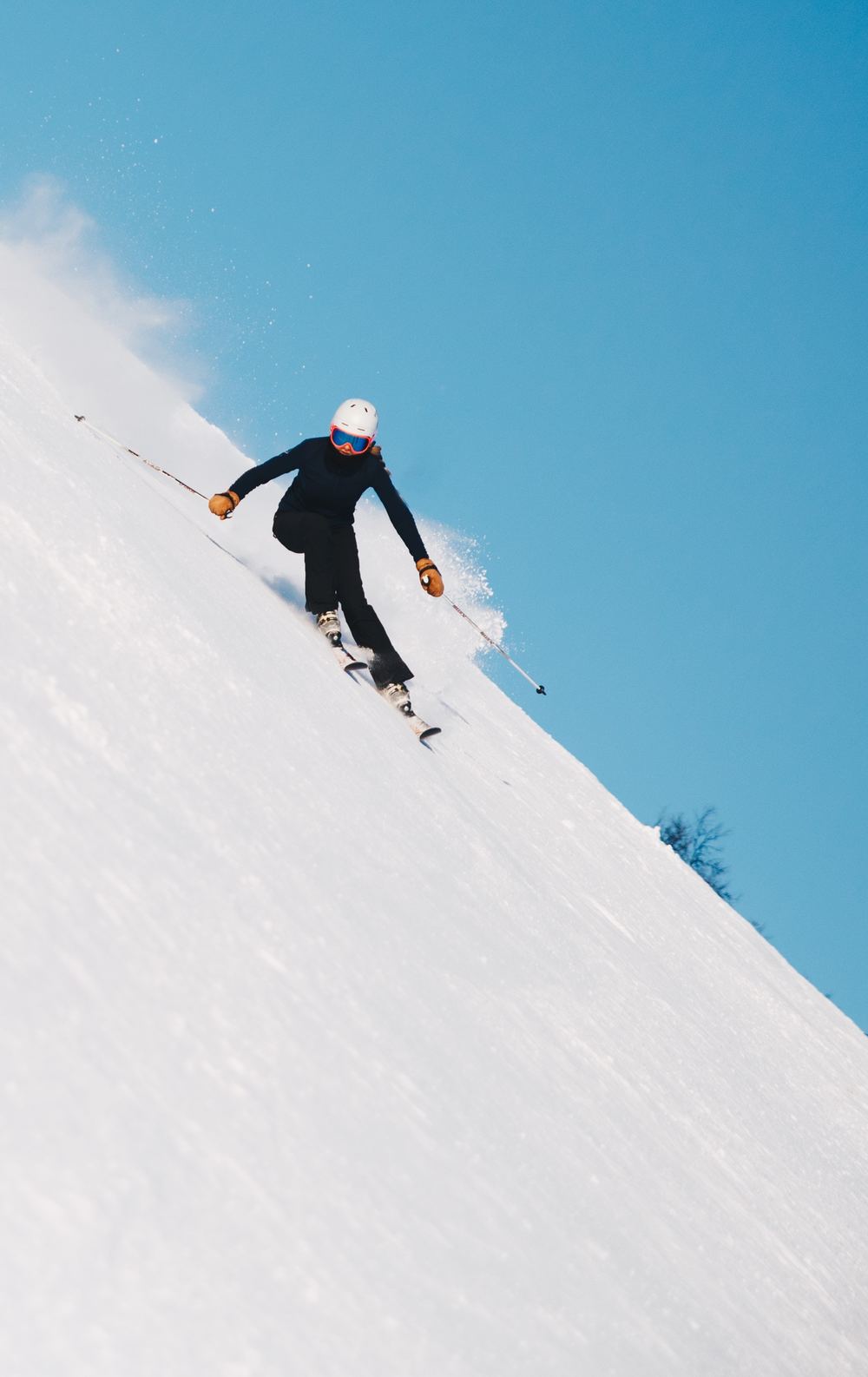
Personal or Rental Powder Skis: A Note
If you decide to learn how to ski powder at a particular lodge, you may be in luck. Renting your ski equipment for the day means that you will have access to the best a ski lodge can provide.
You’ll likely have the opportunity to try out brands you couldn’t buy for yourself as a beginner, and you can swap around until the most comfortable option is found.
The benefits of renting your skis are many, but if you’re learning how to ski heavy powder on a regular basis, you should explore purchasing your own equipment.
By buying your own skis, boots, and poles, you can truly customize your experience and build up preferences for brands over time. However, this is the more expensive option.
When deciding whether to rent your skis or to purchase them, consider how often you’ll ski in powder and then make your decision accordingly.
Techniques for Skiing Powder
Once you have gathered all the necessary equipment, you can hit the slopes and prepare to start skiing – though, perhaps it’s not quite that simple.
Since skiing through powder does require the full use of your body, it also requires the actual powder.
You’ll want to keep a close eye on the weather around your preferred skiing region, and once the ideal combinations of forces strike – go!
Just be sure to keep some of the following skills in mind.
Center Yourself
Balancing your weight on the skis is essential when you’re learning how to ski in powder.
Finding your center and remaining settled will ensure that you do not take any dangerous tumbles over the course of a run.
It takes time to learn the small ways your weight should be shifted and redistribute while skiing, of course. Pay attention to your body as you are making your way down a hill. Do you favor one side over the other?
Noticing these small things and adjusting yourself accordingly will undoubtedly help you maintain your overall balance.
Strong Stance
Much like any variation of skiing, you’ll want to ensure that your stance, when you’re preparing to ski through powder, is a strong one. Your balance, as has been mentioned, is essential.
Be prepared to adjust the position of your feet while skiing in order to maintain it, as well as to stay comfortable over the course of a run.
Keep your core tight, too; this will allow you to better stay in control of your skis. Finally, your line of sight is just as likely to dictate where you end up on a slope as your skis themselves are.

When you’re ready to set off down the hill, choose a destination and go for it – you’ll get there in no time at all.
3D Skiing
You would think that all skiing takes place in three dimensions, and you wouldn’t be wrong – however, when downhill skiing, you only have to worry about moving in two directions: forward and side-to-side.
When you’re skiing powder, not only do you have to keep yourself moving forward and through any necessary turns, but more often than not, you have to be prepared to propel yourself upward through a significant amount of snow.
Think of skiing powder much like skiing moguls; the two variants of skiing are actually quite similar. At the top of a powdery slope, pick a path and stick to it; this concentration will ensure that your ride is all the easier.
Take care to keep your turns shallow, as well. Adjustments that are too dramatic are less likely to help you stay in control, and more likely to leave you with a face full of snow.
Plant Your Poles
You’ll definitely want to use your poles when skiing through powder – not only because they can help with your balance, but because they can aid in your turns.
When changing course and skiing through powder that comes up to your thighs, you’ll want as much help as possible. You can only lean so hard, too, without keeling over on your side.
Your poles are there to help you continue progression forward, while also avoiding any head-on collisions with unmoving trees.
Likewise, should you find yourself slowing down over the course of a run, due to, perhaps, getting stuck in a snowdrift, you can use your skis to dig yourself out of trouble and to set yourself back on your way.
Nothing is worse than losing progress you can’t regain!
Speed
It might be a bit unnerving to let yourself gain speed while zipping through deep, fluffy snow, but don’t let any fears overwhelm you.
A quicker pace can make skiing through powder simpler, as well as more enjoyable. Moving quickly down a hill can keep you from getting stuck in place; just make sure your response times are as fast as your skis!
Powder ski courses are often littered with trees, not to mention other people, so try and pick up the pace all you want, but don’t cause any accidents.
Here’s a video with more detail and tips on skiing powder.
Patience
Above all, learning how to ski powder requires patience. You’ll find, after your first time, that the whole of your body is sore, as this variant of skiing requires a lot of muscle work.
Allow yourself time to become a better skier and to adjust to the workload that this task demands. After several times out on the slopes, you’ll find that skiing through powder comes all the more naturally to you.
Be patient and keep practicing, and the results of your hard work will arrive.
Do you have any tips for skiing powder?

